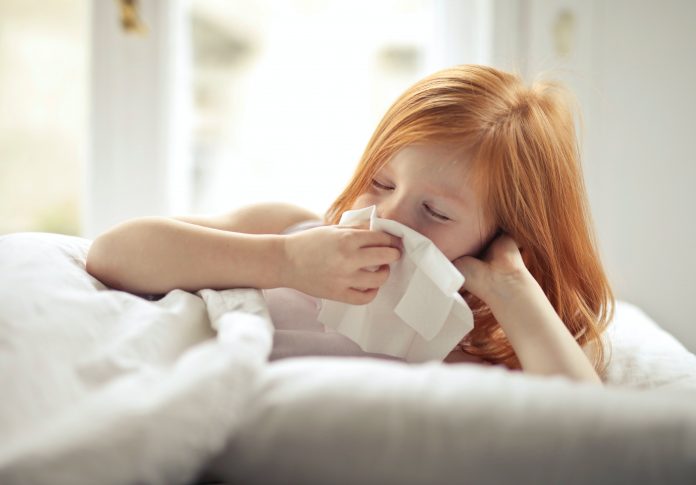Increasing numbers of infants and children are missing school and other critical developmental activities because of the current triple threat. The triple threat comprises COVID-19, the seasonal flu, and a lesser-known virus. This lesser-known virus is the respiratory syncytial virus (RSV) and used to be a yearly virus floating around. RSV and its associated RSV symptoms have resurfaced and is causing a lung and airway illness surge, with 2022 seeming particularly vicious in volume and severity.1
Where did RSV go?
After managing the COVID-19 pandemic, people were pleasantly surprised that RSV infections were limited. The years of COVID-driven isolation and mask-wearing kept RSV under control.
Closing daycares, schools, and other places of high transmission curbed the spread of many respiratory illnesses.1 Unfortunately, the lack of RSV exposure during the pandemic prevented kids from developing particular necessities of immunity. Because these youth didn’t acquire the immune system benefits, we now have a surge of RSV.1
What is RSV?
RSV is a virus that causes symptoms that feel like a common cold. Many characteristics of RSV are the same as a cold, from how it spreads to what it feels like—think of symptoms like coughing, sneezing, and runny noses.2
For vulnerable people like kids who are still developing their immune systems, RSV is dangerous. RSV infections are currently the leading cause of hospitalizations for infants in the United States.3
Who needs the most protection?
Vulnerable populations include the elderly, those with compromised immune systems, and those with developing immune systems, like infants and children.4 Untreated or advanced RSV infections can lead to other dangerous illnesses like pneumonia. Vulnerable populations have a much harder time combatting the symptoms of RSV and are likely to need hospital-based support.4
How to stay safe
RSV symptoms can vary and be tricky to identify. To ensure a healthy fall and winter season, it’s a good idea to avoid crowds, wear a mask when around others, and stay on top of hand washing. Talk to your primary care provider and follow their advice on testing and treatment when in doubt. Additionally, consider the following three options.
- Know your environment and employ common sense. RSV spreads through droplets and moisture from sneezing and coughing.2 If your child’s school or daycare seems to have many parents calling in with sick kids, keep your kids home for a few days to monitor for symptoms and lessen the spread. In addition, if your child starts coughing and sneezing, keep them away from grandma and grandpa for a few days.
- Clean, Clean, Clean. Viruses can live on surfaces.2 If there is a sick child at home, but there are still plans for a get-together, remember that the virus lingers on surfaces hours after exposure. Frequently wipe surfaces with proven solutions that kill bacteria and viruses. And while you’re at it, wash your hands thoroughly and help the kids wash theirs!
- Stop touching the cute chubby cheeks. I know it’s hard, but grandma shouldn’t be in the baby’s face, pinching and kissing those cheeks if either party has a cough or runny nose. Moms, telling family members and strangers not to touch your babies is okay! One reminder not to get in the baby’s face could be the difference between being home for Christmas and being in the hospital.
Reducing the chance of RSV becoming a severe illness for the vulnerable people in your life comes down to common sense and good preparation. RSV is not new, and there is hope for more treatments and the possibility of a vaccine soon.1 However, as RSV is particularly vicious this season, it’s best to keep everyone at arm’s length when the sniffles hit.
References
- Abbasi J. “This Is Our COVID”—What physicians need to know about the pediatric RSV Surge. JAMA. Published online November 11, 2022. doi:10.1001/jama.2022.21638
- Centers for Disease Control and Prevention. Respiratory syncytial virus. U.S. Department of Health & Human Services. (2022). Accessed on November 23, 2022. https://www.cdc.gov/rsv/about/transmission.html
- Suh, M., Movva, N., Jiang, X., Reichert, H., Bylsma, L. C., Fryzek, J. P., & Nelson, C. B. (2022). Respiratory syncytial virus burden and healthcare utilization in United States infants <1 year of age: Study of nationally representative databases, 2011-2019. The Journal of Infectious Diseases, 226(Suppl 2), S184–S194. https://doi.org/10.1093/infdis/jiac155
- Oliva J, Terrier O. Viral and bacterial co-infections in the lungs: Dangerous liaisons. Viruses. 2021; 13(9):1725. https://doi.org/10.3390/v13091725



